In the fall of 1977 I published The Grotesque in Photography, the first critical survey of that mode — and, remarkably, almost 40 years later, still the only such overview to date.
In an October 2015 post I wrote in some detail about the making of that book. But right now it’s featured in “Clarence John Laughlin and His Contemporaries: A Picture and a Thousand Words,” an exhibition at The Historic New Orleans Collection, celebrating the life and work of Clarence John Laughlin, who died 32 years ago, on January 2, 1985, and whose work appears in that book of mine.
•
Clarence John and I had met in person a year or so before I embarked on this book project, sometime circa 1975. A small dinner party provided the occasion, hosted by the painter and art historian Emanuel Navaretta at the upper east side apartment he shared with his paramour, the oncologist Shelley Brown. Emanuel had an interest in photography, particularly from the southern U.S.; he knew Clarence John, and Lyle Bongé, and Jonathan Williams, the poet and publisher of Jargon Books, who championed photographers from that part of the country.
Emanuel and I had met somewhere along the line, he’d read my work, knew that I’d written favorably about Laughlin’s work. So he had suggested me to Clarence John — who would make a rare trip to New York from New Orleans to take care of a number of matters — as a guest at this little gathering. Laughlin had read some things I’d written about his work and agreed, so there we were — me, my girlfriend Tricia Grantz, Emanuel, Shelley, and Clarence John.
The evening had a second purpose, Emanuel had confided to me when extending the invitation. He hoped to interest Sam Wagstaff in acquiring some of Laughlin’s work for his collection. So Wagstaff would stop by after dinner, to meet Clarence John for the first time and have an informal chat. This struck me as an odd dynamic; as a rule, collectors and artists don’t negotiate sales with members of the press present. But Emanuel clearly wanted me there, so he — perhaps Laughlin too — saw me, or at least my presence, as somehow enhancing (or, perhaps, ameliorating) the situation. So I agreed with alacrity; I wanted to see what happened.
Clarence John pretty much dominated the conversation from the moment we stepped through the door till the end of dinner. None of us objected in the least; to the contrary, we asked questions and prompted him for story after story. He seemed quite comfortable occupying center stage, covering everything from escorting Edward Weston around the Big Easy to his darkroom setup, which involved printing in a darkroom in one part of town and then lugging his fixed and washed prints in a bucket of water via streetcar back to his living loft for drying and finishing.
In due course the dishes got cleared away, we moved from the dining area into the living room for dessert and coffee and cognac, and Wagstaff showed up. Emanuel made introductions all around. After a few pleasantries Wagstaff folded himself onto a couch while Clarence John went into another room, coming back with several dozen prints, which he placed in a stack on the coffee table, taking an armchair for himself.
Clarence John started explaining what he required from anyone whom he allowed to buy his prints. He wanted them shown regularly, of course, and expected notification of the where and when of any exhibition, preferably with copies of invitation cards, press releases, and accompanying materials for his files. He should be notified if it got sold, especially at auction. And of course Clarence John wanted his pictures, when displayed, always accompanied by his lengthy captions, because he viewed them as integral components of what he conceived of as image-text works.
Wagstaff listened to all of that quietly, while browsing through the prints, in which activity I joined him. Then he replied. At this remove I don’t recall exactly what he said, just that basically he would have none of it. If he bought something he owned it. He could hang it on his own wall, stick it in a box under his bed, use it as a coaster, scale it out the window, sell it — it was his, to do with as he pleased. Photographers were welcome to track the exhibitions he created from his collection, but he didn’t feel any obligation to notify them of those. As for the inclusion of the captions, that would be up to him and the curators of the institutions hosting the shows.
A silence followed. I didn’t consider it my place to say anything, and had nothing useful to add. As a rule, I advocate for photographers’ rights, but I happened to agree with Wagstaff on this. After a minute or so Clarence John gathered up his prints and took them back into the other room. Sam rose, saying he had to go. Clarence John came out, handshakes all around, and Sam left.
Clarence John was upset at what he saw as Wagstaff’s arrogance, and said so in no uncertain terms. We all commiserated with him to some extent, though Emanuel tried mollifying him while also pointing out the fringe benefits of inclusion in Wagstaff’s collection, already becoming high-profile. But Laughlin wouldn’t hear of it.
We finished our drinks and got up to go. Knowing that we had driven in from Staten Island, Emanuel asked if we would drive Clarence John down to his Times Square hotel en route. Of course we agreed. They fetched our hats and coats. We said our goodbyes. A battered suitcase had appeared, obviously Laughlin’s. Raised properly, and just half Laughlin’s age, I reached down to pick it up … and couldn’t. It must have weighed 60 pounds.
Shouldering me aside, Clarence John — stockier than me, but also shorter by several inches — bent to his right, grabbed the suitcase handle, tilted to his left and hoisted it. All those years of shlepping his prints in water buckets on the streetcar had toughened him. He moved toward the door. I stepped ahead to open it, he lurched through, and we followed, with a hasty wave at Emanuel and Shelley in their doorway.
Clarence John lugged that suitcase to our car and, once we parked in a garage by his seedy hotel on 43rd St., from the car up to his room. We went up with him, just to see him to his door, but he asked us in so he could grouse for awhile more about Wagstaff’s rudeness, the high-handedness of collectors in general, and such. Eventually we said goodnight and drove home, discussing en route this prime example of failed matchmaking.
I understand that eventually Wagstaff did acquire some of Laughlin’s work, though whether he did so directly from its maker or through a gallery or dealer I can’t say. If he negotiated with Clarence John, I have no idea what deal they struck — most likely just what Wagstaff had described. But I respected Laughlin for taking the position he did that evening, not much different from what European artists had achieved for themselves around that time.
•
The New Orleans show — which I haven’t seen, and won’t get to visit — opened on November 15, 2016 and will run through March 25, 2017. As you can see, it includes a copy of the book, along with my letter inviting Laughlin to contribute images to it and his letter accepting that offer. (A tip of the hat to my colleague Harris Fogel, who made and supplied me with these installation shots, triggering these recollections.)
Seeing this brings up the memory of an extremely mortifying moment connected to this book. As a matter of course, I asked the participating photographers for press prints suitable for high-quality duotone reproduction. Most responded by providing unmounted prints on single- or double-weight photo paper, the standard back then for such purposes — basically disposable. But several sent dry-mounted exhibition-quality prints, Laughlin and Max Waldman among them.
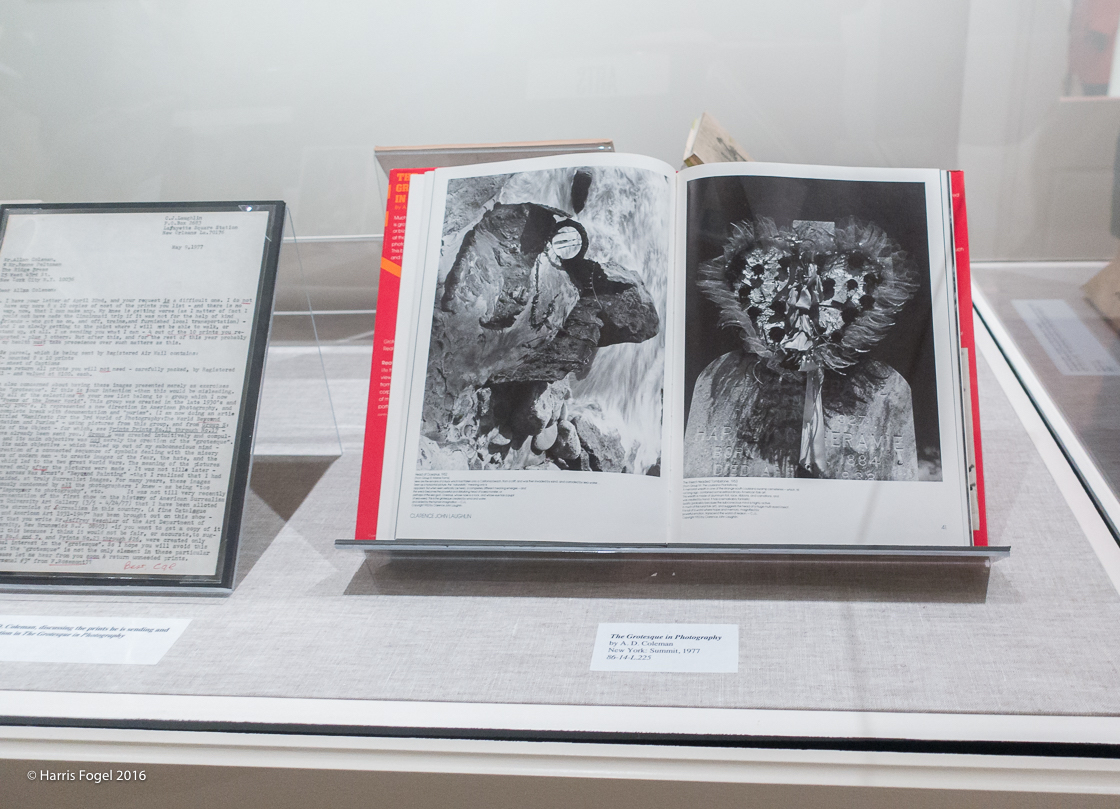
Clarence John Laughlin portfolio, “The Grotesque in Photography,” exhibition display, Historic New Orleans Collection, November 2016. Photo © Harris Fogel.
They had all mailed their prints directly to the Manhattan-based book packagers with whom I worked on this project. Ridge Press specialized in photo books; having collaborated with Edward Steichen on the book version of The Family of Man, and produced numerous photo books thereafter, they knew photography and photographs and didn’t bat an eye when those dry-mounted prints came in. I showed them the accompanying letters from Laughlin and Waldman, asking them to take special care with those prints; they nodded, told me that their insurance covered everything, and I thought no more about it.
I got to see the layout boards, for which they had generated Velox prints from those press prints, scaled to the layout. I found the design way more magazine-like than I’d have preferred, but that was their house style, and I didn’t have much say over it. Then Albert Squillace, their art director, flew over to Italy with the prints and the boards to watch over the press run, and I had no further role in the production.
Al came back in the late summer of ’77, as I recall, with a few advance copies of the book and the prints. They called me up, asking me to come in to the office and take a look. Al, publisher/editor Jerry Mason, and editor Adie Suehsdorff met me there, in the conference room, to show me the results of our labors.
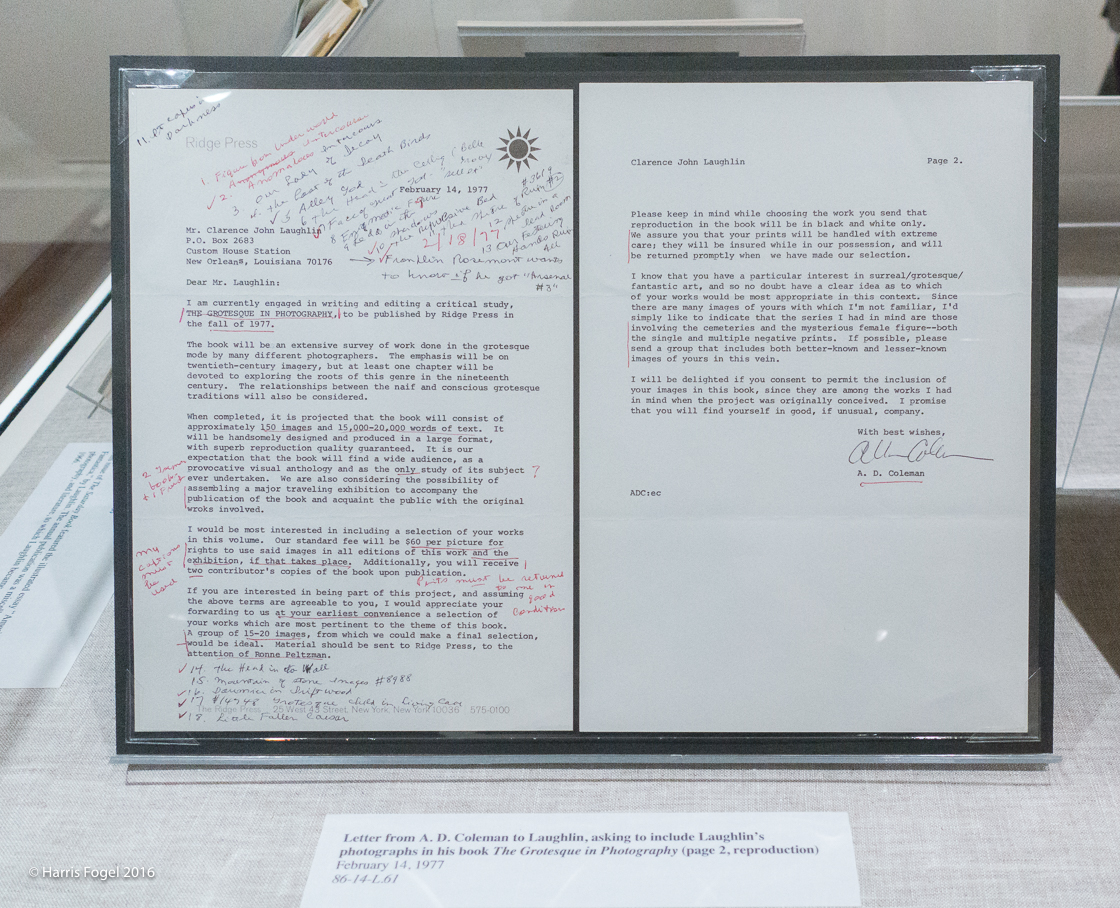
A. D. Coleman, letter to Clarence John Laughlin re “The Grotesque in Photography,” exhibition display, Historic New Orleans Collection, November 2016. Photo © Harris Fogel.
The dust jacket, with its bright red color and silly comparison to the Impressionists, took me by surprise; they hadn’t shown me the dummy of that. And the flashy layout, with pictures bled to the edges of the pages and run across the gutters, didn’t serve the images — or the book’s theme — as well as a more restrained, classic monographic approach would have done.
Nonetheless, there it lay, finished and immutable. Approaching it with the yardstick of the 90/10 rule (if you get 90 percent of what you want, fuck the other 10 percent), I declared myself satisfied.
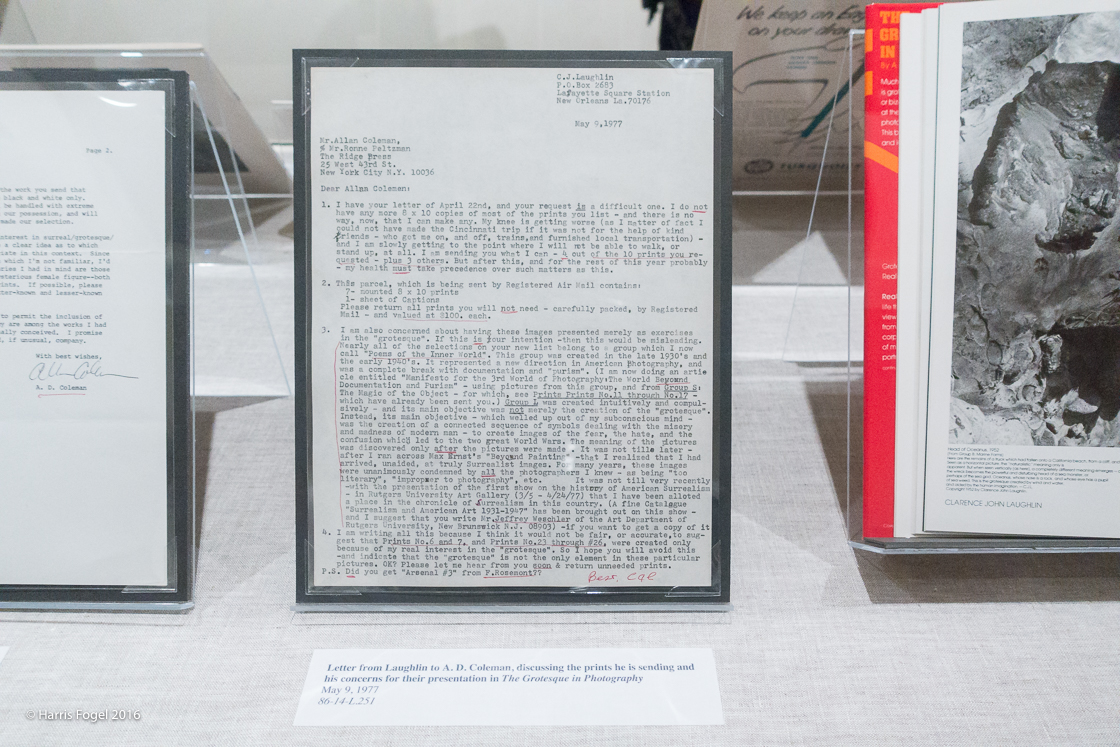
Clarence John Laughlin, letter to A. D. Coleman re “The Grotesque in Photography,” exhibition display, Historic New Orleans Collection, November 2016. Photo © Harris Fogel.
Then Al and Adie, who had served as my text editor for the book, cleared their throats. “We ran into a small problem,” they said, looking embarrassed, and pulled out a dozen or so prints, all of them dry-mounted. I saw immediately that these were the Laughlins and Waldmans. They slid them across the conference-room table to me.
At first I couldn’t see anything out of the ordinary. Then, looking closer, I saw that the corners of the prints were held down to their backing boards with pieces of clear adhesive tape. On closer inspection, I found that the surfaces of these prints were uneven — pebbled, as if something had gotten under them.
This was particularly noticeable in the case of Clarence John’s prints. He sealed the surfaces of his prints with a coat of Devoe and Reynolds High Gloss Industrial Floor Varnish No. 8900, which he flowed onto the prints with a special brush in an idiosyncratic print-finishing process before dry-mounting them. (I’m not making this up)
Aside from minor yellowing, this did not affect the archival quality of his prints. However, that thin varnish coating was extremely brittle, which meant that even the slightest flexing of the print on its mount board would result in crackling its surface. These prints of his were covered in tiny fissures.
Aghast, I looked at Al and Adie for an explanation. Sheepishly, Al recounted their misadventure. He hadn’t thought to get copy negatives of those prints made before he left for Italy, and when he got there the printers were ready to go to press. The vacuum table that they used to hold the prints down while they photographed them for the printing plates wasn’t designed for mounted prints; it wouldn’t hold them in place. So they had very carefully pulled these prints off their backing boards, photographed them, and then glued them back on their mounts, taping the corners down for good measure.
In short, for the sake of the book they had ruined these prints.
My mind raced. I tried to imagine how I would explain this disaster to the photographers, and couldn’t. I didn’t even dare to envision their looks on their faces as they opened the return packages and saw what had befallen their hard work.
I could think of only one solution. Speaking to them all, but mainly to head honcho Jerry Mason, I said, “You told me you’re insured. These prints got damaged in production. You’re buying them. All of them. At the photographers’ current gallery prices. You’ll keep the prints. I’ll write to each of them on your letterhead saying just that, instructing them to bill you. Otherwise, this is your problem, and you can deal with them.”
They looked at each other. In the late ’70s this probably added up to a maximum of $5K for all the destroyed prints. Insurance almost surely would cover it. Jerry nodded; then they all nodded. And so it went.
Mercifully, this New Orleans show doesn’t include my apologetic letter to Clarence John, explaining the destruction of his prints, taking responsibility for it, and urging him to submit an invoice to Ridge Press for their full list price. Which he did, and which got promptly paid.
Fortunately, that disaster did not affect our amicable relationship, which survived it, as you’ll see in my next post.
•
Anyhow, take a moment to think of Clarence John, one of the medium’s grand eccentrics, accurately described by A. J. Meek, professor emeritus of art at Louisiana State University, in the subtitle of his Laughlin biography, Clarence John Laughlin: Prophet without Honor (University Press of Mississippi, 2007).
(To be continued.)
•
This post supported by a donation from photographer Harry Wilks.
•
 Special offer: If you want me to either continue pursuing a particular subject or give you a break and (for one post) write on a topic — my choice — other than the current main story, make a donation of $50 via the PayPal widget below, indicating your preference in a note accompanying your donation. I’ll credit you as that new post’s sponsor, and link to a website of your choosing. Include a note with your snail-mail address (or email it to me separately) for a free signed copy of my 1995 book Critical Focus!
Special offer: If you want me to either continue pursuing a particular subject or give you a break and (for one post) write on a topic — my choice — other than the current main story, make a donation of $50 via the PayPal widget below, indicating your preference in a note accompanying your donation. I’ll credit you as that new post’s sponsor, and link to a website of your choosing. Include a note with your snail-mail address (or email it to me separately) for a free signed copy of my 1995 book Critical Focus!
 Donate now and I’ll include a copy of The Silent Strength of Liu Xia, the catalog of the 2012-13 touring exhibition of photos by the dissident Chinese photographer, artist, and poet, currently in her sixth year of extralegal house arrest in Beijing. The only publication of her photographic work, it includes all 26 images in the exhibition, plus another 14 from the same series, along with essays by Guy Sorman, Andrew Nathan, and Cui Weiping, professor at the Beijing Film Academy.
Donate now and I’ll include a copy of The Silent Strength of Liu Xia, the catalog of the 2012-13 touring exhibition of photos by the dissident Chinese photographer, artist, and poet, currently in her sixth year of extralegal house arrest in Beijing. The only publication of her photographic work, it includes all 26 images in the exhibition, plus another 14 from the same series, along with essays by Guy Sorman, Andrew Nathan, and Cui Weiping, professor at the Beijing Film Academy.



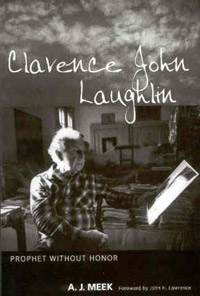
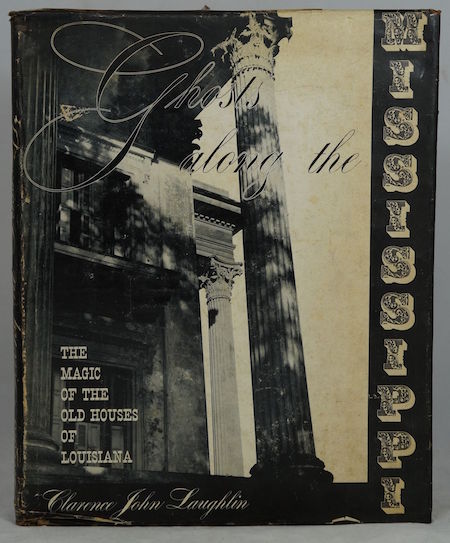
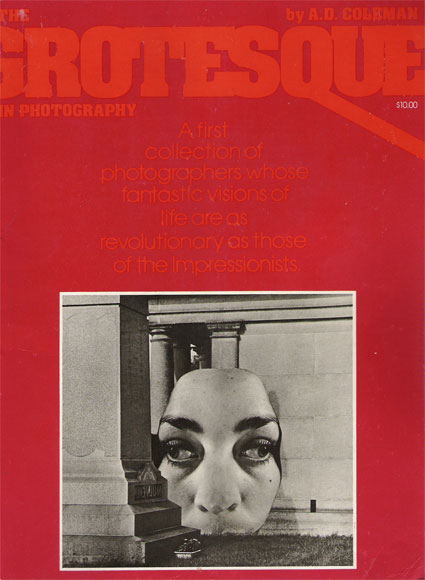




What a great story. CJL was one of my inspirations as I started in photography. He essentially made his images one of kind with the varnish and mounting treatment. I wonder what became of the prints after the insurance payout?
I’m pretty sure Ridge Press didn’t return them to the photographers. Today I think of them as historic artifacts, but back then I couldn’t bear to look at them, so I didn’t get them. (I did end up with the printing plates, somehow.) Best guesses: Those prints either went into the trash or into the Ridge Press files on that book. And lord knows where those ended up when this book packager eventually folded.
Mr. Coleman,
Thank you for posting this interesting story. I happened to read it Monday morning at Newark airport on my way to New Orleans for a conference. Not only was my hotel a few blocks from the museum but a break on Tuesday coincided with the museum’s limited weekday hours so I was able to see some of Laughlin’s prints in person for the first time. I also quite enjoyed the testy letter exchange between Laughlin and Minor White about a proposed article in Aperture. Anyway, it turned out to be the highlight of my trip and I thank you.
It’s funny, I feel almost slighted by Wagstaff’s New Yorker mentality of “I’m gonna do as I see fit with my prints” and for not understanding the other side of the art experience and I’m from Biloxi, not even a New Orleanian. What’s crazy is C.J. Laughlin was major OCD so it was just the nature of the beast. I love to hear stories about my heroes. I have some of his works…
So far ahead of his time. Great piece. Thank you Mr. Coleman…